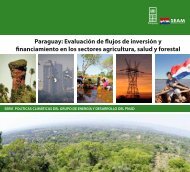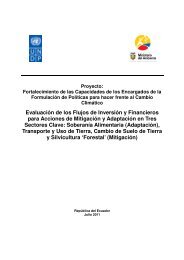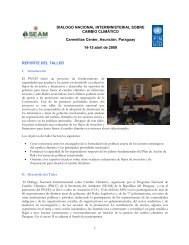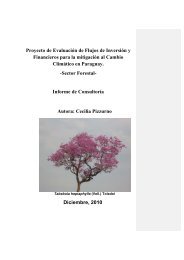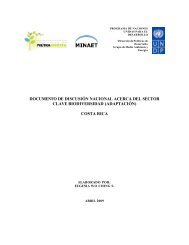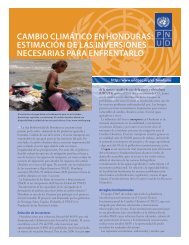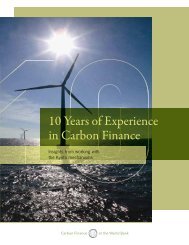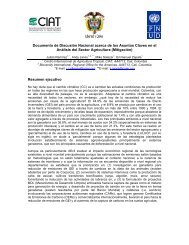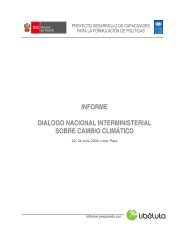View Publication - UNDPCC.org
View Publication - UNDPCC.org
View Publication - UNDPCC.org
Create successful ePaper yourself
Turn your PDF publications into a flip-book with our unique Google optimized e-Paper software.
5 Cannady — Access to Climate Change Technology by Developing Countries: A Practical Strategy<br />
licences but rather of development collaboration<br />
or strategic joint venture contracts in which IP<br />
licences are but one element.<br />
Finally, centring the climate change debate<br />
on compulsory licensing would be of limited<br />
practical utility because, as noted above,<br />
climate change technology patents are often<br />
not filed in developing countries. For all of the<br />
above reasons, it would be unfortunate to use<br />
international climate change negotiation as a<br />
way to gain acceptance of a legal procedure<br />
that is already available in theory but difficult<br />
to exercise in practice.<br />
2.2 Patent Information/Databases<br />
Patent information databases have been proposed<br />
as a quasi-technology transfer to provide<br />
access to climate change technology. 22 Patent<br />
information consists of the text of granted<br />
patents and published patent applications,<br />
including the abstract, specification, drawings<br />
and all-important claims. WIPO has been<br />
particularly active in advocacy of patent<br />
information as a special tool for developing<br />
countries to use IP since 1975 when it started<br />
the WIPO Patent Information Service, which<br />
engaged in the then useful task of printing<br />
hard copies of patents and sending them in the<br />
mail to developing country requesters. 23 The<br />
Internet and increasing patent sophistication<br />
have led to a new iteration of patent services in<br />
the form of PatentScope, a WIPO database that<br />
aggregates PCT patent data from developed<br />
and developing countries. 24<br />
WIPO’s frequently stated position is that patent<br />
information offers a “goldmine” of technology<br />
guidance to developing countries and that<br />
improvements based on nuggets extracted from<br />
this goldmine can be used and commercialized<br />
to good effect. There are some anecdotes to<br />
support the goldmine claim, but to a large<br />
extent it is as founded as claims of gold in the<br />
hills usually are.<br />
Patent information from large patent jurisdictions<br />
is arranged and published by governments<br />
and private parties and can be searched for<br />
free, using keyword searches and numerical<br />
classifications by any person with access to a<br />
computer and the Internet. An example of a<br />
public database is the European Union’s (EU)<br />
EspaceNet website, which includes free access<br />
to the full text of patents and patent applications<br />
from all over the world. 25 The United States<br />
Patent and Trademark Office (USPTO) website<br />
also offers full text patent searching, which<br />
is free to anyone and easy to use. 26 Private<br />
companies also publish and charge for access<br />
to patent databases with some added-value<br />
features that are generally necessary only for<br />
law firms conducting litigation searches or for<br />
patent examiners.<br />
Patent databases can be searched to learn<br />
details about climate change technology<br />
patents. The full text is generally available.<br />
However, search and study of the text of<br />
patents does not amount to technology transfer,<br />
for several reasons. Reading the claims of an<br />
invention relating to a wind turbine or to carbon<br />
nanotubes for water filtration does not grant a<br />
legal right to use the technology. If the patent<br />
was not filed in the country where the reader<br />
plans to make, use or sell the technology,<br />
then the reader is free to imitate (copy) and<br />
use the invention, as long as another patent<br />
does not interfere. However, if the patent was<br />
issued in the reader’s country, then the reader<br />
is forbidden from using the invention for a<br />
period of approximately 20 years. Making an<br />
improvement that builds upon the issued patent<br />
does not necessarily insulate the diligent user<br />
of patent information from liability, as he or<br />
she may have to practise one or more claims<br />
of the underlying invention in order to use the<br />
improvement.<br />
Another reason why access to patent data is not<br />
synonymous with access to technology is that<br />
reading the claims of a patent is like seeing a<br />
part of a larger picture. Patent claims are legal<br />
statements to define bounds of an invention,<br />
but they are not a recipe for reproducing the<br />
invention.




